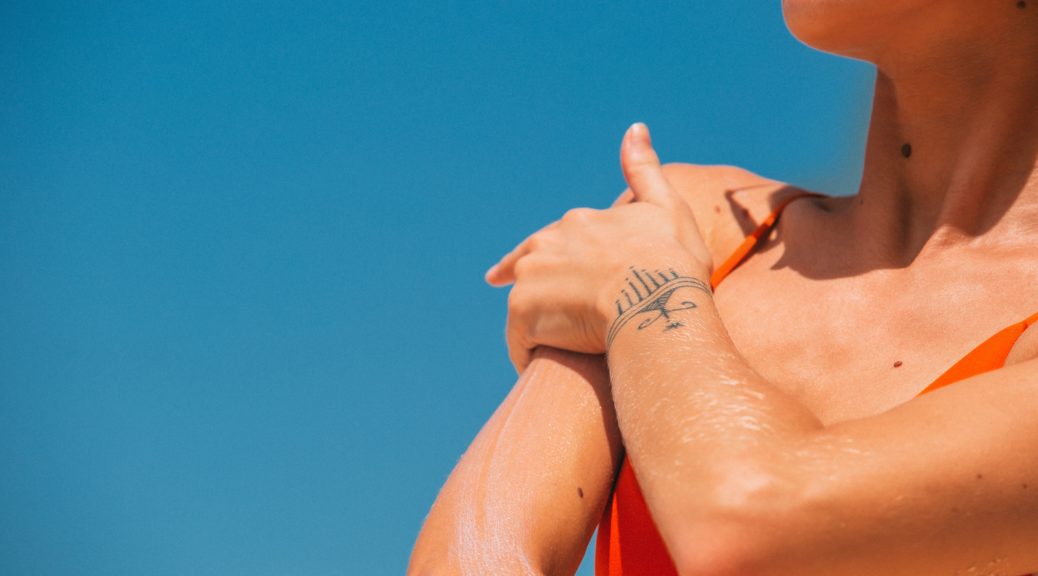
Sun protection in pregnancy and breastfeeding
It’s summer in the northern hemisphere and temperatures are rising, so many families may wonder about the most appropriate sun protection for themselves and their children.
The importance of sun exposure for any living being and also the need for protection to avoid skin problems are well known. Sun protection is a key element for this time of the year, and choosing the one that best suits each situation is important.
Sunlight
The sun emits energy in the form of radiation, a mixture of rays or waves. Some are harmless, such as long waves, and others are more harmful, such as ultraviolet radiation.
However, ultraviolet (UV) radiation also promotes vitamin D synthesis as well as tissue damage.
UV radiation is classified into three main types: UVA, UVB, and UVC. The ozone layer completely absorbs UVC and much of UVB radiation. Therefore, the waves received on Earth are UVA and part of UVB.
- UVA: UVA rays penetrate the skin and are responsible for sun tanning. Consequently, they accelerate skin aging and the appearance of wrinkles.
- UVB: UVB rays penetrate the skin only slightly and are responsible for skin burns.
Risks and benefits of the sun
The sun is essential for living beings and provides important benefits such as:
- Helping the body with the synthesis of vitamin D
- It has an anti-inflammatory effect against some dermatological diseases: promotes healing of psoriasis lesions and some dermatitis and helps to prevent and control skin acne.
- Improves sleep cycles as it regulates melatonin supply.
- Improves the mood.
As for Vitamin D: this helps the body absorb calcium and phosphorus from food and contributes to bone formation, avoiding conditions such as rickets or osteoporosis, as well as playing an important role in the nervous, muscular, and immune systems. On the other hand, vitamin D deficiency leads, among other things, to fatigue, pessimism, depression, muscle weakness, nervousness, or insomnia.
Therefore, the importance of sunlight in our health is understood. However, it can also be harmful if there is constant and uncontrolled exposure to sunlight without appropriate protection.
Sun protection creams
Sun protection in the form of creams, lotions, or serums uses the acronym SPF (Sun Protection Factor) to indicate the time of exposure to the sun to avoid sunburn.
The SPF measures protection against UVB; as UVA is variable and its measurement is complicated and applying sun cream or lotion every 2 hours at the most or after swimming is recommended.
There are two types of filters for sun protection:
- Mineral filters: they are not absorbed through the skin, causing UV light to bounce back most of its radiation, thus preventing it from entering the skin. They are not absorbed, especially if they are not formulated as nanoparticles. Typically, the components used are titanium dioxide and zinc oxide.
- Chemical filters: They penetrate the skin and perform their action by absorbing radiation and transforming it into harmless radiation.
Sun protection in pregnancy, breastfeeding, and babies
It is known that several chemical sunscreen filters act as endocrine disruptors and are susceptible to affecting the genital-sexual system and the hypothalamic-pituitary-thyroid axis of the infant. In various studies, these compounds have been found in human milk in varying amounts, although much lower than the necessary doses studied with endocrine-disrupting effects.
In any case, the long-term effects of chronic exposure to endocrine-disrupting chemical sunscreens are unknown, so physical sunscreens are preferable during breastfeeding (5).
In the case of protection for babies, the general recommendation is to avoid sun exposure in the central hours of the day and, if necessary, the use of sunscreen with a high SPF, broad-spectrum physical filter is recommended for infants older than 6 months of age. It should be applied prior to sun exposure and every 2 hours or before going into the water. Other measures can be added, such as the use of sunglasses, sun hats, and sun-protective clothing. This clothing is labeled with the acronym UPF, Ultraviolet Protection Factor, similar to the sun protection factor, but for fabrics.
As for the stages of pregnancy and breastfeeding, there are not enough studies on the use of sun protection, although the recommendations seem to prefer the use of physical protection (shade, clothing and screens) and, if possible, without the presence of nanoparticles. When breastfeeding, it is also advisable not to apply sunscreen on the area of the breasts.
References:
- https://www.elsevier.com/es-es/connect/ciencia/beneficios-salud-del-sol
- MedlinePlus en español [Internet]. Bethesda (MD): Biblioteca Nacional de Medicina (EE. UU.) [actualizado 27 ago. 2019]. Vitamina D; [actualizado 12 noviembre 2021; consulta 16 jun. 2023]; [aprox. 5 p.]. Disponible en: https://medlineplus.gov/spanish/vitamind.html
- https://www.cdc.gov/nceh/radiation/nonionizing_radiation.html
- https://www.cdc.gov/spanish/nceh/especiales/radiacionuv/index.html#:~:text=La%20radiaci%C3%B3n%20ultravioleta%20(UV)%20es,causar%20riesgos%20para%20la%20salud.
- https://www.e-lactancia.org/breastfeeding/topical-sun-protector-cream-lotion-gel/synonym/